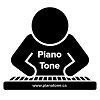
Hi there! This is my review of the Piano For All online piano course by Robin Hall. I heard about this course from a friend and decided to give it a try in 2021, and was impressed enough that I thought I should do a review. I haven’t completed all 9 modules yet, but I am far enough in to have a pretty good take on how and why this course works so well; so I may update this page later with more information.
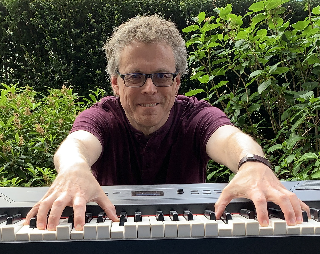
Who Is This Course For?
This course is for anyone who wants to get started on playing the piano; the course is actually a great fit regardless of your specific interests (classical with sheet music OR modern music with just chord charts) because it is divided into modules so you can focus on your specific area(s) of interest.
Piano For All – Overview
Piano For All has actually been around for quite a while and as it turns out is one of the most popular online piano courses that there is (not sure how it took ME so long to check it out :). The course is unique both in its approach to teaching piano, but also in how the course is delivered.
Piano For All – Course Format
Piano For All consists of 9 interactive eBooks; once you make a one time (lifetime membership) payment, you can download all 9 books, and access them with any standard eBook reader app/software.
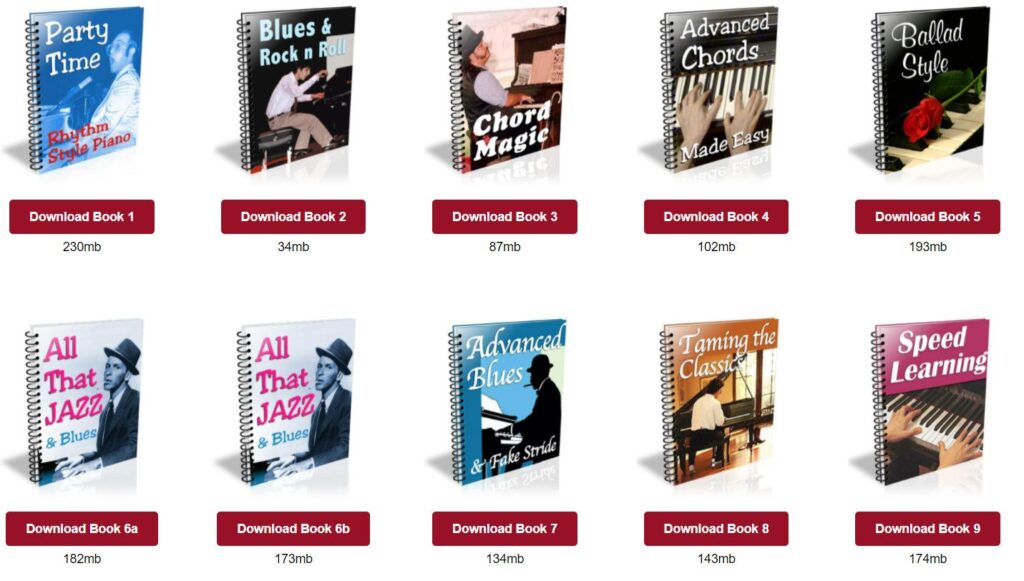
For example on my iPad the built in “Books” app works wonderfully; on a pc, there are tons of free/not free software choices for you. The cool thing about this format, is that these books are not only text, but have videos and sound clips embedded within the book – so you don’t have to be online to use these, AND you don’t need to bounce back and forth between apps, windows, YouTube etc like you do with many other courses. So for each topic, you can play an overhead video where Robin explains and demonstrates the topic being covered, then you can read about that topic, and also play additional sound clips:
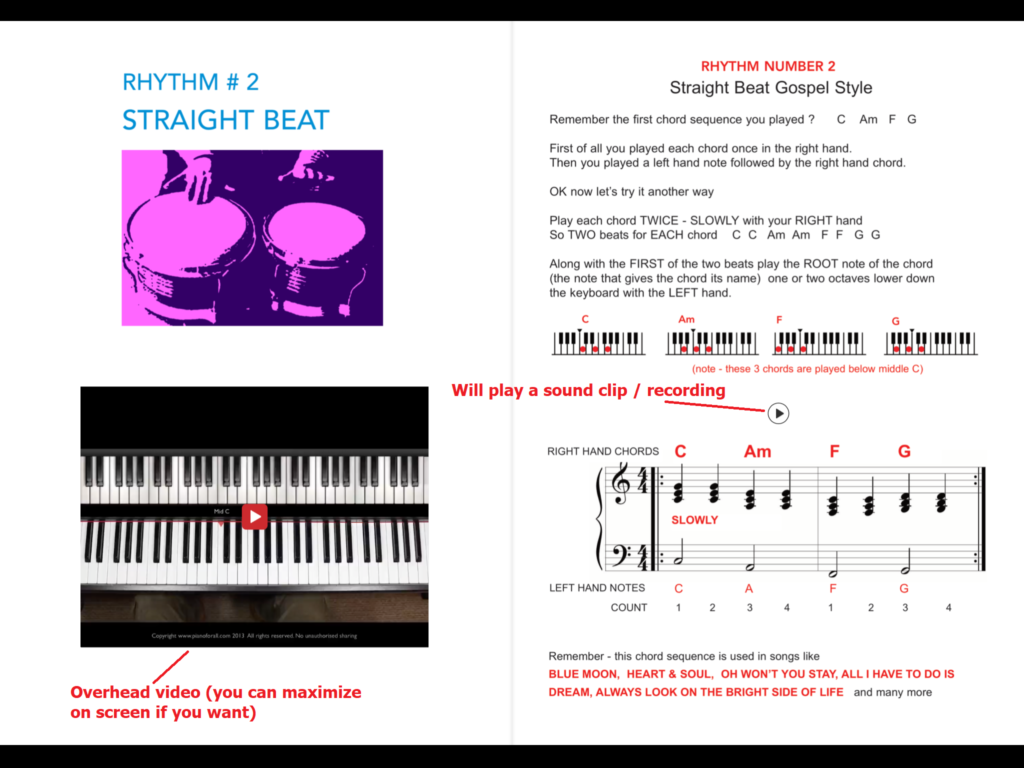
Piano For All – Approach To Teaching Piano
I learned how to play piano from other online courses (Piano in 21 Days & The Piano Man Approach) that are both fantastic courses that teach piano using a chord based approach (there is ZERO sheet music/sight reading in those courses; it is true that you do not NEED to be able to read sheet music to learn piano!). Piano For All actually takes the “getting you started playing” even a small step further than other chord based courses by not even teaching at the outset how and why chords are formed the way they are – he just shows them to you and says “just do this for now, I’ll explain why later”. He uses a great example that I can relate to from having taken tons of guitar and bass lessons when I was young – if you take beginner guitar lessons, your guitar teacher is NOT going to tell you “OK memorize all the notes on the guitar and let’s get started on sight reading Mary Had A Little Lamb and practicing scales”; they will instead tell you “put your fingers here – this is a C chord – don’t ask why I’ll explain that later just do THIS” and will teach you some strumming basics (rhythm! more on that in a bit) to get you started. And getting you started actually playing something is fun and satisfying which keeps you playing and learning!
Learning piano with a chord based approach is definitely the fastest way to get started, and works wonderfully for modern music. However, if you DO want to also be able to play classical music or even if you just want to have a more complete learning experience, then you will need to work on reading sheet music. This is where Piano For All’s teaching approach is really very well thought out, and works great whether you are interested in classical / reading sheet music or not. Books 1-4 give you a chord based foundation that get you playing (and having fun) quickly, and then you can build on that foundation with more advanced books before tackling (if you WANT to) classical and reading sheet music.
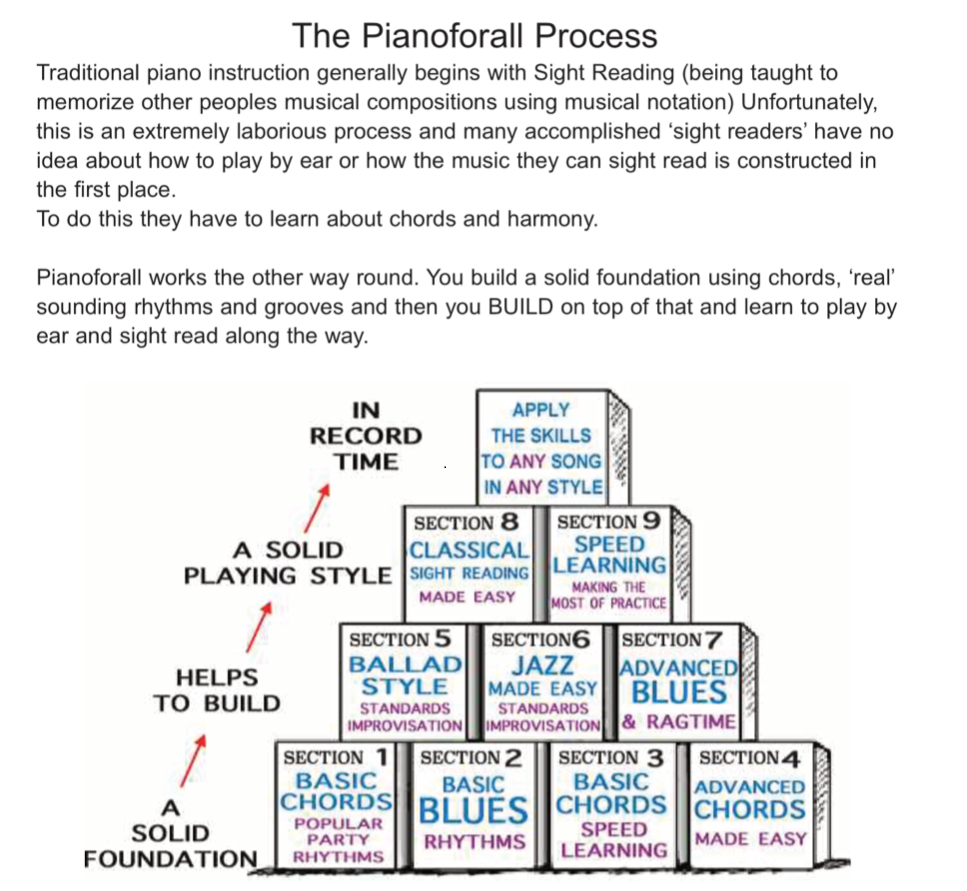
Books 1-4: The Foundation
Books 1-4 do a fantastic job of getting you started playing, using a chord based approach. But there are a couple of extra things that are thrown in to this process that make a massive difference in your playing as well as setting you up for later success with reading sheet music if that interests you.
Teaching You Rhythm FROM THE START
It’s one thing to learn how to play chords, which does allow you to get started playing songs quickly, but to have your playing actually SOUND like the song, you also need to learn how to incorporate rhythm patterns into your playing. This is something that differentiates The Piano Man Approach from Piano in 21 Days; the Piano Man Approach course makes HEAVY use of left hand rhythm patterns that immediately make your rendition of a song sound much more accurate and keep all your songs from sounding the same. While playing with rhythm is very challenging, completing the Piano Man Approach elevated my playing to a whole new level.
Piano For All has you learning simple basic common left hand rhythms and walking bass lines right from the start which gets you used to coordinating your left and right hands. I actually wish I had included more rhythm in my playing right from the start instead of having to learn it later, so Piano For All does a great job of this! And even with all the left hand rhythms I learned from the Piano Man Approach, I learned (and am continuing to learn) MANY more awesome rhythms from Piano For All.
Including Sheet Music In All Examples – But NO Actual Reading Yet
Robin includes sheet music in almost all the examples in the book right from the start, but does NOT expect you to be reading any of the notes; instead it is there for you to have a “general sense” of the shapes , patterns and rhythm. He will also include chord symbols which not only starts showing you what a chord looks like in sheet music, but also starts getting you ready to read lead sheets if that interests you. This is a very smart way to get you gradually exposed to sheet music.
For example in the picture below, in the bottom right, you can glance at that and see that you are playing an alternating left – right hand rhythm with bass notes (indicated) for the left hand and chords indicated for the right. This is not only a great base to build on for learning to read music later, but it is also super useful even for those players not interested in learning to sight read – having a basic ability to look at sheet music and understand “what is going on” is a super useful skill.
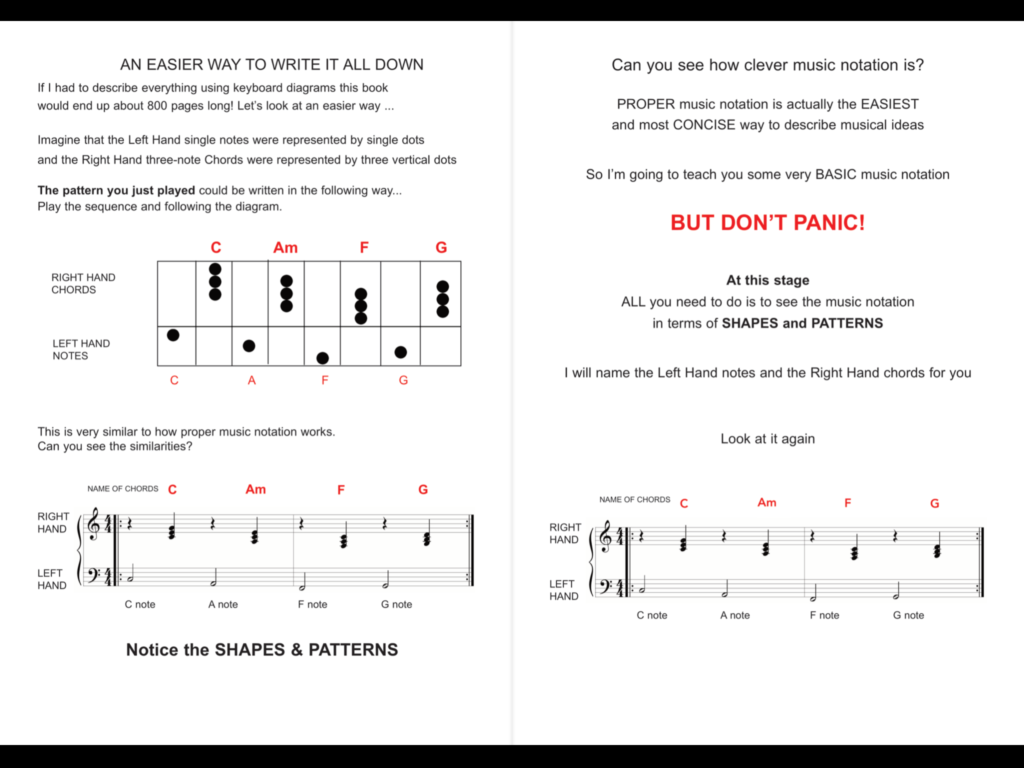
Books 5-8: The Advanced Stuff & Classical / Sheet Music
Once you work through the first four books, you really do have a great solid foundation to start tackling the harder material in books 5-9. At this stage, I am still working on the first 4 but have browsed through the remaining books and personally am really looking forward to books 5-7 (ballads, blues and jazz – those are right up my alley!). I may even test out the “Tame The Classics” book once there to try and beef up my very minimal sheet music skills.
Book 9: “Speed Learning”
Book 9 is a MASSIVE resource for tips and tricks, practice routines & daily workouts etc. This book contains a TON of super useful reference material and exercises. Depending on your incoming musical knowledge this might be a book you could work on at any time during the course. If you are a true beginner, then you should probably leave it for last, or maybe wait to skim it until you are finished with the “foundations” books (1-4). I am still a beginner but have been playing for a couple of years now, so I actually quickly read/browsed through this book looking for helpful tips, tricks and exercises appropriate for my skill level, experience and interests, and found some great material (blues exercises and workouts – once again right up my alley!). And it is also good to have a general idea of what this book contains while you work through the rest of the course so you can refer to it when appropriate.
Piano For All – Package Options / Cost
Piano For All has one very simple pricing option – pay once, get lifetime access. And the best part? This course is (in my opinion) ridiculously inexpensive – it includes an almost staggering amount of material, and at the time of writing this review only costs about $79 USD (and also at the time of writing this review, you will often find it on sale for considerably less than that even!
With so much material offered for SUCH a low price, to me it was a complete no-brainer to buy this course. Even though I am still working through other courses, this is simply silly to pass up.
Piano For All – The Verdict
I love this course; I love the approach, the format, the content, and most of all the price! I can highly recommend Piano For All for pretty much any aspiring (or maybe even better than aspiring) pianist. Even if you have been playing for a while and find that alot of the material is just review, you will STILL get great value from Piano For All; an experienced pianist will get access to some great exercises and workouts just from book 9 that given the low price of this course would be well worth the money.
So with all that being said, I can highly recommend Piano For All – if you want to check the course out further, please click my affiliate link below. And I also have a link to my full video review as well if you want to check that out.
Thanks so much, and happy piano playing!
